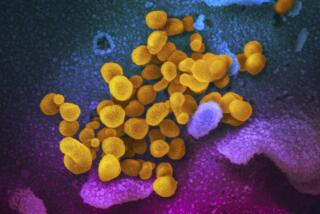Building a better mouse to study Ebola
Scientists wearing anti-pathogen “spacesuits” and working in a government biocontainment laboratory have shown that genetically diverse strains of mice can accurately model the devastating health effects of the Ebola virus, according to new research.
In a paper published Thursday in the journal Science, researchers argued that collaboratively-bred lab mice can now replace monkeys as Ebola research animals -- a development that could save scientists money and help avoid potential ethical dilemmas in future research.
Traditionally, scientists have used macaques, guinea pigs and Syrian hamsters to study the virus, but not lab mice.
The reason for this, according to senior author Michael Katze, a microbiology professor at the University of Washington, is that while Ebola will kill conventional lab mice, it will not provoke the same symptoms seen in humans.
“It killed mice, but it didn’t produce hemorrhagic fever symptoms,” Katze said. “When you’re testing drugs and vaccines, its important that you stop the symptoms that appear in humans. That’s why the nonhuman primate model has been the gold standard. But using nonhuman primates is really financially and ethically difficult.”
Study coauthor Angela Rasmussen, a microbiology researcher at the University of Washington, said that inbreeding of lab mice was the root of the problem.
“Most of the conventional laboratory strains ... only have about 10% the overall genetic diversity in mice,” Rasmussen said.
For their research, the study authors used Collaborative Cross project mice, mice that are bred by an international group of researchers. Collaborative mice cover 90% of the diversity of the species.
“They’re really more comparable to genetically diverse populations such as humans, but they’re reproducible,” Rasmussen said. “We know exactly how one mouse is different to another.”
Researchers at the National Institutes of Health Rocky Mountain Laboratories in Hamilton, Mont., infected the diverse mice with a special mouse-adapted strain of Ebola.
As Katze and his colleagues suspected, the mice exhibited a variety of symptoms that mimicked those in humans: Some mice developed severe hemorrhagic fever and organ damage, while others were completely resistant.
The researchers said that they were also able to identify genes that may influence virus susceptibility.
“The model described in this paper can be implemented promptly to identify genetic markers, conduct meticulous pathogenesis studies, and evaluate therapeutic strategies that have broad-spectrum antiviral activity against all Zaire Ebola viruses, including the virus responsible for the current West Africa outbreak,” the authors concluded
Follow @montemorin for science news







